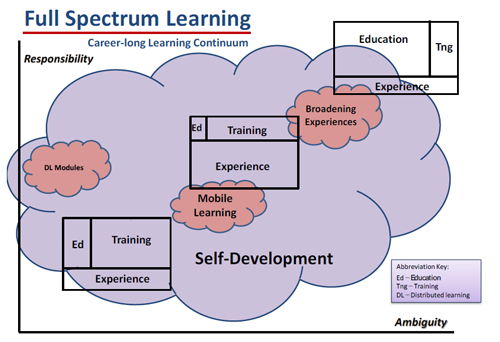James Murphy, a former F-15 fighter jet pilot and now CEO of a team building company, notes in a recent article that “complexity is the mortal enemy of good execution, and our world is nothing if not increasingly complex.” Thus, in order to execute in an ever increasing complex word, we need to break it down in simple steps:
- Planning: If your planning process tries to run the whole gauntlet of complexity then you will simply get beat up by it, so use short-tem timelines.
- Briefing; Get everyone on the same page.
- Executing: Just do it.
- Debriefing. The purpose of the debrief is to make adjustments ... to discover lessons learned. This can best be accomplished by performing an After Action Review:
- What were our intended results?
- What were our actual results?
- What caused our results?
- What will we sustain or improve?
- Repeat process so that you are refining and continually improving.
OODA
Col. John Boyd, USAF (Ret) has a similar process called the OODA Loop:
- Observe: Scan the environment and gather information from it.
- Orient: Use the information to form a mental image of the circumstances and place it into context.
- Decide: Consider options and select a subsequent course of action.
- Act: Just do it.
- Repeat process so that you are refining and continually improving.
Both Murphy and Boyd say that no matter how complex the environment is, when you do this, you stay at the same rate of competitive change in the complex environment or slightly ahead of it ... thus you win. Murphy also notes that confidence leads to courage, and courage leads to a bias towards action. This planning process gives people that courage regardless of the situation.
Probe, Sense, Respond
David Snowden of Cognitive Edge also has a similar tool for dealing with complexity in his Cynefin model:
- Probe: Make a change (prototype) in the environment in order to test it.
- Sense: Review it by determining the impact of the probe.
- Respond: Depending upon the result you achieve you either amplify the probe or suppress it, and then repeat.
Agile Design
And the last one for dealing with complex environments — Agile Design:
- Select the project and develop the vision.
- Initiate the project by obtaining stakeholder participation, funding, and build team.
- Deliver small working iterations that meet the changing needs of the stakeholders. Continue this step until:
- Release (End Game) by deliver the final package.
- Production: operate, maintain and support the system.
There are four other design models beside Agile that you can use depending on the complexity of the environment.

These tools, Murphy's Process, AAR, OODA, Cynefin, and Agile Design are designed for working in complex environments. What other processes or models do you use for dealing with complexity?
